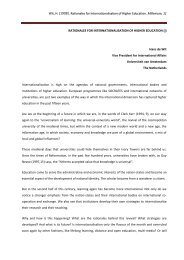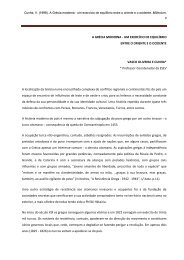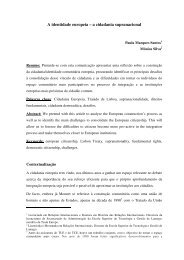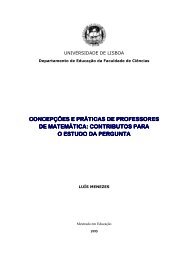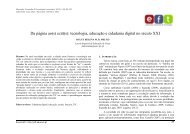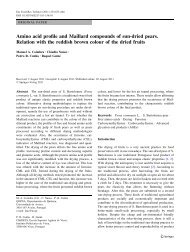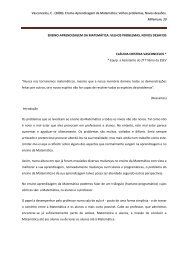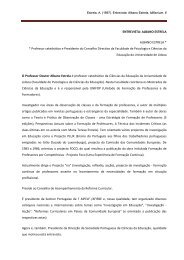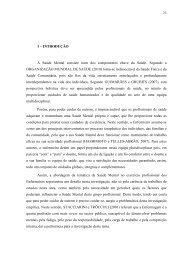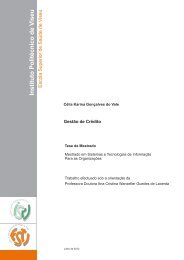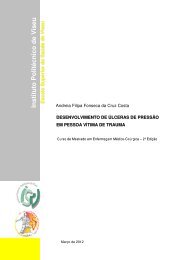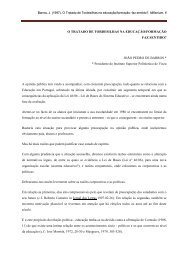CERVEIRA Joel Andrade RESUMO.pdf
CERVEIRA Joel Andrade RESUMO.pdf
CERVEIRA Joel Andrade RESUMO.pdf
You also want an ePaper? Increase the reach of your titles
YUMPU automatically turns print PDFs into web optimized ePapers that Google loves.
<strong>RESUMO</strong><br />
Introdução: O AVC surge entre as principais causas de incapacidade e deturpação<br />
funcional. Para GREVE (2007), a mensuração da independência/dependência funcional,<br />
permite o acompanhamento da evolução do doente no seu processo de reabilitação.<br />
Objectivo: Comparar as diferenças na evolução funcional através da aplicação da MIF na<br />
admissão na UC de Anadia, ao fim de um mês e ao fim de três meses, identificando as<br />
variáveis com maior impacto na independência funcional.<br />
Metodologia: Estudo baseado numa análise quantitativa, descritivo-correlacional e<br />
transversal que constou de 105 sujeitos: sexo masculino (54,30%) e sexo feminino (45,70%)<br />
com o diagnóstico de AVC, sendo o Isquémico mais representativo da amostra (83,80%) no<br />
território da ACM (59,00%). As idades estiveram compreendidas entre 39 e 95 anos com<br />
média de 73,92 anos e Dp de 12 anos.<br />
Resultados: Através dos testes de Friedman, Mann-Whitney e Kruskall-Wallis, constatou-se<br />
diferença significativa entre as três aplicações e a independência funcional. Os homens com<br />
lesão hemisférica esquerda influenciam a independência funcional da primeira para a<br />
terceira e da segunda para a terceira aplicações. A continuidade com reabilitação revelou-se<br />
significativa na recuperação funcional. Os doentes com apenas uma ocorrência de AVC<br />
apresentam melhor funcionalidade da primeira para a segunda aplicação. Verificada<br />
diferença significativa da coabitação na independência funcional na Locomoção e<br />
Mobilidade. O tipo de AVC, Hemisfério afectado, continuidade com reabilitação e a primeira<br />
ocorrência de AVC influenciam a independência funcional em dimensões específicas para<br />
cada variável referida.<br />
Conclusão: As variáveis clínicas exercem uma maior influência na independência funcional<br />
quando testadas dimensão a dimensão. A existência de diferenças estatisticamente<br />
significativas destas variáveis na independência funcional é de uma forma geral, mais<br />
verificada em indivíduos do sexo masculino, com apenas um enfarte isquémico à esquerda<br />
e que dão continuidade à reabilitação. Estas diferenças variam em função das dimensões da<br />
escala.<br />
Palavras-chave: Independência Funcional; Acidente Vascular Cerebral; Reabilitação.
ABSTRACT<br />
Introduction: The AVC appears among the leading causes of disability and functional<br />
misrepresentation. To GREVE (2007), the measurement of independence / functional<br />
dependency, allows monitoring the evolution of the patient in their rehabilitation process.<br />
Objective: To compare the differences in functional outcome through the application of the<br />
FIM on admission to the UC Anadia, after one month and after three months, identifying the<br />
variables having the greatest impact on functional independence.<br />
Method: A study based on quantitative analysis, descriptive-correlational and cross that<br />
consisted of 105 subjects: male (54.30%) and females (45.70%) with diagnosis of stroke,<br />
being more representative of Ischaemic sample (83.80%) in the MCA territory (59.00%). The<br />
patients were aged between 39 and 95 years with a mean of 73.92 years and SD of 12<br />
years.<br />
Results: Over the Friedman test, Mann-Whitney and Kruskal-Wallis test showed significant<br />
difference among the three applications and functional independence. Men with left<br />
hemispheric lesion influence the functional independence from first to third and second to<br />
third applications. Continuity with rehabilitation was significant functional recovery. Patients<br />
with only one occurrence of stroke have better functionality from first to second application.<br />
Significant difference in cohabitation in functional independence in mobility and locomotion.<br />
The type of stroke, affected hemisphere, rehabilitation and continuity with the first occurrence<br />
of stroke affect functional independence in specific dimensions for each variable above.<br />
Conclusion: Clinical variables exert a greater influence on functional independence when<br />
tested dimension to dimension. The existence of statistically significant differences in the<br />
functional independence of these variables is in general, most occurred in males, with only a<br />
left ischemic infarction and who continues to rehab. These differences vary depending on the<br />
size of the scale.<br />
Keywords: Functional Independence; Stroke; Rehabilitation.




